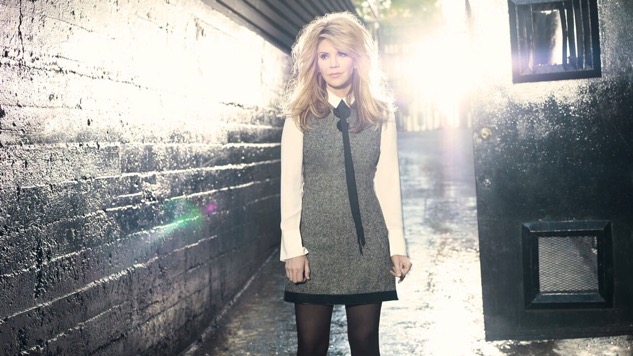Parting Shots: Alison Krauss

Alison Krauss’ new album, Windy City, is her first release in six years—the longest span between albums of her career. “This record took so long to finish because I got burnt out ” she explains. “I was having a lot of vocal problems, and I just couldn’t figure out why nothing was feeling right. I saw a vocal coach and I asked, ‘Why am I not liking anything I’m hearing?’ And he said, ‘Because you’re too distracted. You’ve got too much stuff on our desk. When you get all this stuff done, then go back and sing.’”
She did just that through the encouragement and inspiration of producer Buddy Cannon, whose participation initiated the project. While Windy City is a solo record and doesn’t feature all of Krauss’ longtime group Union Station (whose Paper Airplane won the 2012 Grammy for Best Bluegrass Album and topped Billboard’s folk, country and bluegrass charts), three of her bandmates join her on the recording. Sidney and Suzanne Cox, Jamey Johnson, Hank Williams Jr. and several other guests also lend their talents to the captivating 10 songs—some of which are familiar, a few of which are obscure and all of which feature Krauss’ clear, enchanting vocals.
What led you back into the studio to record Windy City?
I don’t go in unless I’m inspired to do it. I don’t go, “Oh, it’s time to make a record.” As soon as I start to contrive something, it doesn’t last; it doesn’t stay interesting. If something’s been inspired, it is always satisfying. It doesn’t get old, and it’ll change with you. Even after 30 years, I can sing the same thing and the story changes in my mind. So what led me to this record was Buddy. I had the same feeling working with him that I do when I hear a song I have to sing. He makes me want to do my best.
There’s a diverse collection of songs on Windy City. How did you come to select “River in the Rain,” from the Broadway show Big River?
Buddy brought that. He told me it was from that play and he said he loved it. I heard it from a female perspective— the river was a man. It was a man personified as a river— the way he came in and tore up the place, flooded it and left. She never knew any better. I thought that was the perfect story.
How about John Hartford’s “Gentle on My Mind,” which is associated with Glen Campbell?
Buddy suggested that one as well. I sang through it one time and it felt natural. I always thought it was beautiful, but I had never sung it. It’s actually interesting you picked that one because I saw the same person I saw for “River in the Rain” for “Gentle on my Mind.”
When you’re performing live, do you try to evoke the same mindset that you had when you recorded a given song?
When I sing stuff live, I don’t try to do anything—usually, it just happens. Anytime I try, it’s usually a mistake. I just kind of do it, and it’s most effective when those things just show up. It’s like if I get distracted in the studio and start to act a little bit. Then it can sound inauthentic. It’s like false emotion.
Speaking of spontaneity, what do you remember about your time recording with Phish [on 1994’s Hoist]?
What was so funny about that is that we were playing in Los Angeles at the Troubadour, and these guys came up and they’re like, “Hey, we’re in this band, and we’re recording out here. Will you come and play on our record tomorrow?” I didn’t know them, but Barry [Bales, Union Station’s bassist] said, “I’ve heard of them.” So I stayed overnight and recorded with them because Barry had heard of them. They could’ve been anybody. [Laughs.] The stuff that I did back then without having a clue about anything is remarkable. It turned out they were the nicest people and they were hilarious. I felt like I’d gone to school with them. “Scent of a Mule”—I still remember that song. [She sings a few lines.]
Then they came through here and I played with them at Starwood Amphitheatre [in Nashville]. I still didn’t know anything about Phish. We played there and that place was packed! I mean, completely packed with people, and beach balls were flying everywhere. I was like, “Who are you guys?!”
It’s been nearly a decade since the release of Raising Sand. Looking back, what did you take away from your experience recording and touring with Robert Plant?
He’s a joy of a person. He’s so into catching a specific moment of time in the studio and realizing how valuable that is. Up until that point, I looked at the studio as another instrument. And it is another instrument, but it’s not more valuable than that moment in time. To watch him sing like that and capture that moment in time with his approach was important to me. It’s important to remember that the studio is not just a process or an instrument or a set of tools.
The most fun part of this job, for me, is singing harmony with someone, and it was a joy to do that with him. When we did it live, though, he would never sing anything the same way twice, so I had to watch him like a hawk. [Laughs.] He’s giggling and he’s turning the other way, and I’m like, “Don’t turn away. I have no idea what you’re going to do! Just let me see what you’re doing!” [Laughs.] I had to be on my toes to watch him because he’s just totally free, and it was a blast.




















